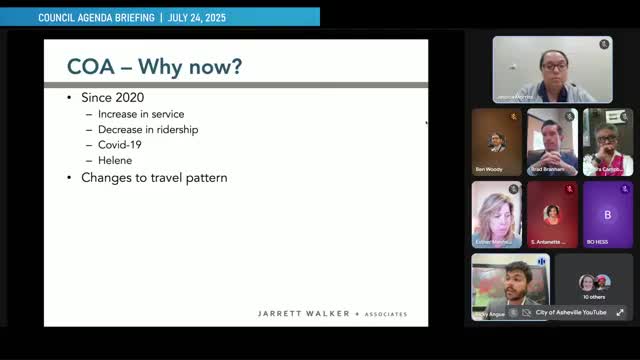Asheville Transit Study Considers Ridership Versus Coverage Goals
July 26, 2025 | Asheville City, Buncombe County, North Carolina
This article was created by AI summarizing key points discussed. AI makes mistakes, so for full details and context, please refer to the video of the full meeting. Please report any errors so we can fix them. Report an error »

Asheville City Council is gearing up for a pivotal decision on the future of its transit network, with a focus on balancing ridership and coverage goals. During a recent agenda briefing, transit experts highlighted the need for a comprehensive review of the city’s public transportation system, which has seen fluctuating ridership patterns due to the pandemic and other factors.
The discussion centered on the importance of frequency in transit service. Experts emphasized that higher frequency leads to reduced wait times and improved reliability, which are crucial for attracting more riders. They presented data showing a clear correlation between service frequency and ridership across various cities, including Asheville. The takeaway? A well-designed transit network should prioritize high-frequency routes in densely populated and walkable areas to maximize utility for residents.
However, the conversation also acknowledged the trade-off between ridership and coverage. While a ridership-focused network could enhance efficiency and attract more users, it might leave underserved areas without adequate service. Councilmember Zoona expressed concerns about geographic equity, stressing the importance of maintaining service in historically underinvested neighborhoods.
The council is set to engage the public in September, seeking input on two contrasting transit network concepts: one prioritizing ridership and the other focusing on coverage. This engagement will culminate in a decision at the November 11 council meeting, where members will determine the future direction of Asheville's transit system.
As the city navigates these complex choices, the emphasis remains on creating a transit network that not only meets current needs but also aligns with broader goals of sustainability and accessibility. The upcoming months will be crucial as Asheville seeks to redefine its transit landscape in a post-pandemic world.
The discussion centered on the importance of frequency in transit service. Experts emphasized that higher frequency leads to reduced wait times and improved reliability, which are crucial for attracting more riders. They presented data showing a clear correlation between service frequency and ridership across various cities, including Asheville. The takeaway? A well-designed transit network should prioritize high-frequency routes in densely populated and walkable areas to maximize utility for residents.
However, the conversation also acknowledged the trade-off between ridership and coverage. While a ridership-focused network could enhance efficiency and attract more users, it might leave underserved areas without adequate service. Councilmember Zoona expressed concerns about geographic equity, stressing the importance of maintaining service in historically underinvested neighborhoods.
The council is set to engage the public in September, seeking input on two contrasting transit network concepts: one prioritizing ridership and the other focusing on coverage. This engagement will culminate in a decision at the November 11 council meeting, where members will determine the future direction of Asheville's transit system.
As the city navigates these complex choices, the emphasis remains on creating a transit network that not only meets current needs but also aligns with broader goals of sustainability and accessibility. The upcoming months will be crucial as Asheville seeks to redefine its transit landscape in a post-pandemic world.
View full meeting
This article is based on a recent meeting—watch the full video and explore the complete transcript for deeper insights into the discussion.
View full meeting
